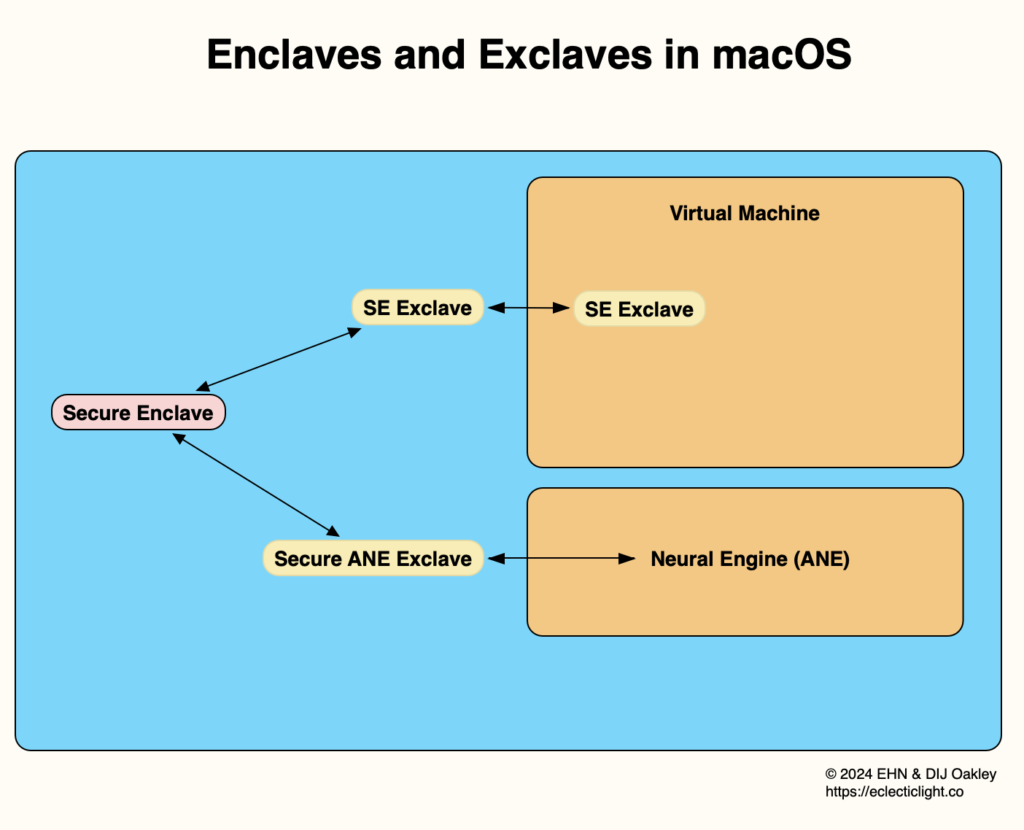Sonoma’s unfinished business: exclaves, conclaves and the kernel

It’s not uncommon for mid-cycle releases of macOS to gain new features in preparation for the next major version. Perhaps the most fundamental and significant added to Sonoma 14.4, together with iOS 17.4, iPadOS 17.4 and watchOS 10.4, are exclaves. As far as I’m aware, this is the first time this term has been used in computing, so before trying to explain what they do for our Macs, I’ll demystify its established use in geography.
Definitions
An enclave is a country that’s entirely surrounded by another country, and it’s easy to see how that matches its meaning in the Secure Enclave, which handles our most important secrets, and provides FileVault encryption. Those are highly secure services provided by a separate processing unit within the main Apple silicon chip, or the T2 in recent Intel Macs.
An exclave is a fragment or part of a country that’s separated from the main part, and lies within one or more countries other than its original country. Although I haven’t come across an explanation of what this represents in computing, for these purposes I assume that an exclave is a resource that’s separated from its parent, for example a small portion of Secure Enclave that’s outside the main part, supporting a virtual machine, perhaps.
Although I hadn’t previously come across the term conclave in computing, Apple is now using it in recent versions of the XNU kernel. This isn’t derived from geography, but is normally used for a private meeting or close assembly, most specifically the meeting of cardinals that elects the next Pope. While there’s scant evidence as to its meaning in this context, I’ll assume that it’s based on that general concept.
Secure Enclaves
Apple introduced its first true Secure Enclave for Macs in the T2 chip in December 2017. This chip consists of a four-core main CPU derived from the A10 used in the iPhone 7 and contemporaneous iPads and iPod Touch, with a 32-bit Arm CPU running a completely different operating system, sepOS (a custom version of the L4 microkernel), dedicated to handling and working with the secrets protected by its Secure Enclave. That has its own secure EEPROM storage, an AES engine to perform hardware-accelerated encryption and decryption for the internal SSD, and more.
The first M1 models released in November 2020 came with an integral Secure Enclave, as have all subsequent M-series chips. These are a significant improvement on their predecessors in the T2, adding replay prevention, a second-generation Secure Storage Component, and more. They continue to run their own operating system, sepOS. Support for biometric authentication using Face ID is implemented as a secure mode in the main Neural Engine (ANE), but apparently remains unused in M-series chips. That secure ANE mode is an exclave of the Secure Enclave.
Exclaves
Prior to macOS Sequoia, macOS virtual machines (VMs) running in lightweight virtualisation on Apple silicon are unable to use Apple ID or to access iCloud, because they’re unable to access any protected secrets from the host’s Secure Enclave. In macOS 15 and later, creation of a VM running macOS 15 or later can configure an identity derived from the host Secure Enclave, enabling access to resources requiring Apple ID including iCloud. This is accomplished using an exclave of the Secure Enclave.
As of macOS 14.6.1, exclaves and conclaves are implemented in and supported by three kernel extensions:
ExclaveKextClient.kext (introduced in macOS 14.0)
ExclaveSEPManagerProxy.kext
ExclavesAudioKext.kext
and two Private Frameworks:
CoreSpeechExclave.framework
libmalloc_exclaves_introspector.framework
These are currently all in version 1.0. If you’re running a beta-release of Sequoia, you might find it interesting to check the version numbers of those components in their respective /System/Library folders.
According to the few comments in the XNU source code, exclaves provide a fixed static set of resources to the XNU kernel. Examples given include conclave managers, services like Apple ID for VMs, named buffers and audio buffers. These resources are named and have a corresponding identifier shared between XNU and the enclave. Those are discovered during the boot process, and made available in a table at two levels. The root table assembles resources by their scope, while secondary tables list actual processes.
For example, a root table entry for the domain com.apple.conclave.a might link to a secondary table listing an audio buffer, an audio service as a conclave manager, and additional buffering. In the case of audio exclaves, they might be used to connect a system extension running with user privileges to privileged access in the kernel and its extensions.
Information about exclaves is hard to come by. Currently, it appears that any log entries originating from exclaves are shown as coming from the kernel. The only time you’re likely to come across more specific information is in the panic log generated following a kernel panic involving an exclave, when the normal content should be supplemented by information from the exclave. These might have improved in Sequoia.
From the evidence in XNU source code and elsewhere, exclaves are intended to support three subsystems:
audio system extensions, allowing them to replace third-party kernel extensions, via ExclavesAudioKext.kext
Apple ID in macOS VMs via ExclaveSEPManagerProxy.kext
secure ANE via ExclavesAudioKext.kext.
Although support for each of these first appeared in macOS 14.4, the second of them, at least, is already functional in Sequoia, but hasn’t been back-ported to Sonoma, restricting its use to Mac hosts and VMs running Sequoia or later.
There are also multiple references to Tightbeam, which doesn’t appear to have been released in open source. This refers to highly focussed lasers used in communications in The Expanse sci-fi. In macOS, it first appeared as the name of a Private Framework released in macOS 13.0, and supported since then. There’s still a great deal more to be discovered about exclaves, conclaves and XNU.
References
Apple’s Platform Security Guide, which explains Secure Enclaves in detail, but doesn’t mention exclaves or conclaves.
Using iCloud with macOS VMs (Apple).
XNU open source on GitHub, see osfmk/kern/exclaves* for instance.




